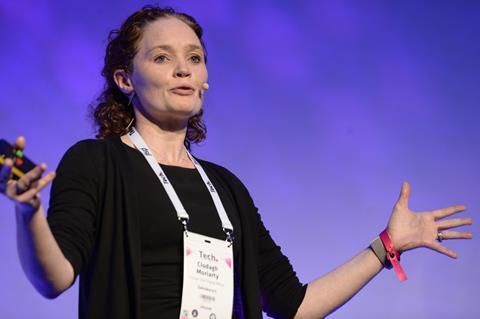“Business models is one of the biggest areas of innovation happening today. Uber, Rent the Runway, Airbnb – they didn’t invent anything, they just changed the business model and that changed the market.”
Innovation catalyst Andrew Vorster made this observation at Retail Week’s Tech. festival – a prescient reminder of the proliferating forces challenging how retailers operate today.
As retail is increasingly influenced by customer trends that span far beyond their traditional and established rivals, what are the trends that will genuinely transform how retailers operate in the coming years?
How we’ll dress tomorrow
The changing relationship that customers have with their clothing – where they buy it, what they expect from it and how retailers should present it to them – was one of the significant themes at this year’s Tech. festival.
The sustainability agenda has shone a spotlight on the fashion sector, forcing retailers to think more sustainably and give more careful consideration to the impact fast fashion is having on the planet. Having adopted an increasingly green mindset, consumers are striving to get more use out of their clothing and are gradually turning to the second-hand market.

Online clothing consignment marketplace ThredUp’s chief technology officer Chris Homer says research by the platform found the size of the second-hand market has already doubled to $24bn (£19.3bn) in the US over the past 10 years, with one in 20 items in shoppers’ closets being pre-owned.
It’s a trend that is set to continue, with Homer predicting the second-hand clothing market will surpass fast fashion sales in the next 5-10 years.
Rent the Runway chief technology officer Josh Builder concurs. When the business launched a decade ago with the intention of leading to the “eradication of ownership and the closet”, it rented clothing exclusively for ‘events’, such as holiday parties and weddings. At that time, its customer base wore Rent the Runway products an average of 2.7 times per year. Since launching its subscription service three years ago, however, that number has rocketed to 120 times per year, which Builder says happened “almost overnight”.
“Attitudes have absolutely shifted. Now people rent out their beds and get in cars with strangers – everything we do has changed,” says Builder. “The second-hand market is another lens of the type of behaviour we want to play on – buying new clothes and new things is incredibly wasteful behaviour.
“There’s a future in which ownership of clothing is totally optional. You might want to own a couple of things, but you don’t need to. The average woman spends almost $4,000 a year on fashion – some of it is fun, but some is utility and can be fully replaced.”
Homer says it is the appetite of customers to purchase more premium clothing brands that initially attracts them to ThredUp, but the business’ sustainability credentials “do help with retention”.
While Homer says an ever-expanding SKU-count – allowing shoppers to hunt for second-hand bargains online in the same way they would rummage through the bargain bin at a thrift store – is key to ThredUp’s business growth.
Stitch Fix chief algorithms officer Brad Klingenberg takes a different approach. “The level of choice people have in retail has gone past the point of being helpful, so curation has become part of the value proposition for shoppers,” says Klingenberg.
Stitch Fix curates its product selection for customers through a combination of an onboarding questionnaire of users when they sign up, analysis of the items they keep and return, and canny methods to keep getting shoppers to voluntarily share data with the platform after they have signed up.
One such way Stitch Fix has done this is through gamification, enabling customers to make picture boards of outfits they like or creating a rating system for looks. “If you want good data from customers, it’s worth building something fun like a game,” Klingenberg says.
While Stitch Fix has been built on data and technology, it blends art with that science. Its stylists curate assortments for customers informed by algorithmic recommendations.
Grocery innovation and the last mile
Dutch grocery etail phenomenon Picnic’s chief technology officer Daniel Gebler says the business, which has amassed a 23% share of the Dutch online food market, has done so by turning the perceived wisdom about how to innovate on its head.
“Traditionally innovation has looked like taking an existing service and adding more to it – but what would a service look like when you offered less instead of more?” Gebler asks.

To this end, Picnic offers its customers just one delivery time slot a day, rather than a list of options at half-hour increments. While, on paper, this seemingly restricts customer choice, Gebler argues that Picnic can offer its customers a better service as a result. Around 99% of the grocery etailer’s orders are delivered within the promised 20-minute window and because one van fulfils inner-city deliveries in close proximity on the same journey, the business has cut down on logistics costs and passed the savings along to the customer.
Another tech firm working to drive convenience for online grocery shoppers is Starship Technologies, the last-mile delivery company that is piloting partnerships with Tesco and the Co-op to fulfil food orders in Milton Keynes.
Starship’s head of interaction design, Markus Zimmerman, says the business has delivered to half of the 6,000 homes its robots can reach across the town – some 1,500 households use the service at least once per week.
Whether or not robots roaming the streets represent a feasible delivery option is something that has been questioned by many observers, with hazards aplenty on roads and pavements. But Zimmerman challenges the notion that delivery robots are a slowly roving invitation to be tampered with by the general public.
In a social experiment where Starship tipped over their own robots mid-delivery, the business found that more than half of passersby helped to set it right in under three minutes – a number that jumps to 95% when the robots made a noise after being tipped over.
That’s not the only perceived wisdom being challenged by start-ups operating in the grocery space. Gebler says Picnic is also looking into how it can change food packaging in a bid to reduce waste.
“Much of the packaging is not necessary,” he says. “A packet of corn flakes, for example, is a third air, and it’s not necessary for ecommerce businesses.

“Customers know they want corn flakes, but they don’t need the packaging [in online retail], unlike in physical retail where it is necessary to attract attention. We will be doing a lot more ecommerce packaging in the future.”
For more established grocers, an additional challenge lies in balancing such innovation around deliveries and packaging with their legacies. Sainsbury’s chief digital officer Clodagh Moriarty explains that the supermarket giant’s switch to using the cloud has enabled it to move from releasing tech updates to customers five or six times a year to multiple times a day.
Although she admits that Sainsbury’s has moved too fast in developing apps in the past – at one point comparing the number of apps it operated to “whack-a-mole” – she said the benefit of working and investing to better serve the online and multichannel shopper is clear.
Moriarty says customers who shop online and in-store spend 2.4 times more than store-only customers, while those who spend across all of the group’s digital propositions, including the Argos app, spend 3.1 times more than a store-only customer.
Shifting tectonic plates
Establishing the technology that will – and won’t – transform retail has long been a conundrum that businesses are wrestling with – and it formed a source of much debate at this year’s Tech. festival. One of the key areas of contention to emerge was AI and the impact it could have on the industry.
Yandex chief data scientist Michael Levin says despite 76% of retailers believing AI will transform their business over the next three years, 85% of all AI initiatives to date have failed.
However, Intel’s vice president of the Internet of Things, Joe Jensen, is confident AI will revolutionise the industry.
“AI is going to change every aspect of your life and how it operates,” Jensen says. “AI is going to usher in an entirely new world of efficiency and effectiveness and better enable you as a business to meet these new customer expectations.”
Microsoft vice president of retail and consumer goods Shelley Bransten agrees. She says retailers will have spent $7.3bn (£5.9bn) on AI by 2022 and predicts that 15% of all customer service interactions will be handled completely by AI by 2021 – a 400% increase compared to 2017.
However, one technology that many retailers are in agreement over in terms of its revolutionary potential is augmented reality (AR).
Adidas worked with Snapchat to develop ‘AR drops’ and create hype for footwear that hadn’t even come out yet. Using AR mapping, Snapchat users could point their phone at their shoes and turn them into the new Adidas trainers. So-called ‘sneakerheads’ were effectively able to try on the new trainers in their own home, or even in rival brands’ stores, and pre-order them with just one click. The trainer got 60 million digital try-ons before it reached shops.
Further Snapchat research found that 58% of its users have purchased an item online while in-store shopping for something else, 59% of people ask friends and family for advice while they are shopping and 58% send a photo or video of products to them while in-store.
“We are ahead of smartphone technology, which makes it less efficient and more pricey to make”
Ronny Mikalsen, Carlings
Danish fashion firm Carlings has used AR to lean into that social media age. Chief executive Ronny Mikalsen explains that the business, which was founded in 1980 but moved online less than a year ago, has taken a thoroughly modern approach to retain its relevance with young shoppers.
Mikalsen says the fashion retailer came up with “virtually fitted fashion items” that people only wear in one photo on social media, in a bid to “give people the tools to be creative and be fashionable, without harming the environment”.
Despite having to part with up to £20 per item for one-time “wear”, Carlings sold out of the products within just four weeks – it set limits on the number of purchases per piece to stop Instagram becoming “flooded” with the same garments.
“It was an eye-opener for us, it was an eye-opener for consumers and it was an eye-opener for the industry,” says Mikalsen.
Although it has established that consumers are happy to pay for digital garments, Mikalsen says Carlings faces a different hurdle.
“Our biggest challenge to get this to be a part of the fashion industry is smartphone cameras,” he says. “We are ahead of smartphone technology, which makes it less efficient and more pricey to make.
“But in the future not far away, the cameras will be able to dress you up in the product straight away in real-time, instead of us having to design it on to you. That will be solved in a short space of time.”
Retailers need to have their eyes open to spot the technology that will change how they operate, without being taken in by the trends that will prove a flash in the pan.


























1 Reader's comment